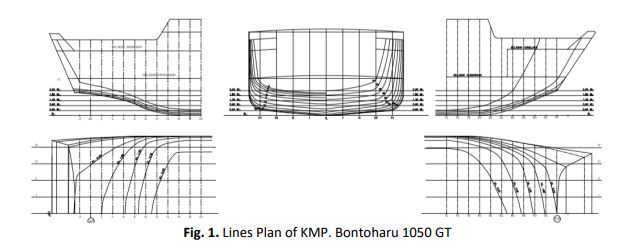Water Depth Effect to Ferry Ship Resistance with Computational Fluid Dynamic Method
DOI:
https://doi.org/10.37934/cfdl.14.5.98105Keywords:
Ferry Ship, Resistance, Deep Water, Medium Water, Shallow WaterAbstract
Predicting ship resistance in shallow water conditions is very important for the operational considerations of a ship. Shallow waters greatly affect viscous resistance, wave resistance and also propulsion efficiency. This study aims to determine the effect of water depth on the resistance of the ferry. The CFD method was used to simulate this phenomenon and its effects on the hull starting from the coefficient of ship resistance, surge force, sway force and yaw (hydrodynamic moment). Input speed at 9 – 13 knots with depth ratio H/T = 4 (deep water), H/T = 3 (deep water), H/T = 2 (medium water), H/T = 1.3 (shallow water), and H/T = 1 (very shallow water). The simulation results show a significant increase in total resistance, surge force, sway force, and hydrodynamic moment in shallow water conditions in every speed variation. This condition is caused by the increase in pressure received by the ship's hull when operating in shallow water.
Downloads
References
Kristensen, Hans Otto, and Marie Lützen. "Prediction of resistance and propulsion power of ships." Clean Shipping Currents 1, no. 6 (2012): 1-52.
Suastika, Ketut, Gilbert Ebenezer Nadapdap, Muhammad Hafiz Nurwahyu Aliffrananda, Yuda Apri Hermawan, I. Ketut Aria Pria Utama, and Wasis Dwi Aryawan. "Resistance Analysis of a Hydrofoil Supported Watercraft (Hysuwac): A Case Study." CFD Letters 14, no. 1 (2022): 87-98. https://doi.org/10.37934/cfdl.14.1.8798
Pacuraru, F., and L. Domnisoru. "Numerical investigation of shallow water effect on a barge ship resistance." In IOP Conference Series: Materials Science and Engineering, vol. 227, no. 1, p. 012088. IOP Publishing, 2017. https://doi.org/10.1088/1757-899X/227/1/012088
Rotteveel, E., and R. G. Hekkenberg. "The influence of shallow water and hull form variations on inland ship resistance." In IMDC 2015: Proceedings of the 12th International Marine Design Conference, Tokyo, Japan, 11-14 May 2015. 2015.
Ammar, Nader R., Mohamed M. Elgohary, Akram Zeid, and Ahmed G. Elkafas. "Prediction of shallow water resistance for a new ship model using CFD simulation: case study container barge." Journal of Ship Production and Design 35, no. 02 (2019): 198-206.
Zeng, Q., R. Hekkenberg, C. Thill, and E. Rotteveel. "A numerical and experimental study of resistance, trim and sinkage of an inland ship model in extremely shallow water." In Proceedings of the International Conference on Computer Applications in Shipbuilding, Singapore, pp. 26-28. 2017.
RoyChoudhury, Seemontini, Anil Kumar Dash, Vishwanath Nagarajan, and Om Prakash Sha. "CFD simulations of steady drift and yaw motions in deep and shallow water." Ocean engineering 142 (2017): 161-184. https://doi.org/10.1016/j.oceaneng.2017.06.058
Nabawi, Rahmat Azis. "Study Reduction of Resistance on The Flat Hull Ship of The Semi-Trimaran Model: Hull Vane Vs Stern Foil." CFD Letters 13, no. 12 (2021): 32-44. https://doi.org/10.37934/cfdl.13.12.3244
Maimun, A., A. Priyanto, A. H. Muhammad, C. C. Scully, and Z. I. Awal. "Manoeuvring prediction of pusher barge in deep and shallow water." Ocean Engineering 38, no. 11-12 (2011): 1291-1299. https://doi.org/10.1016/j.oceaneng.2011.05.011
Muhammad, A. H., D. Paroka, S. Rahman, M. R. Firmansyah, and T. P. Putra. "Characteristics of Turning Circle and Zig-Zag Manoeuvres of An Indonesian Ferry Ship In Shallow Water." In IOP Conference Series: Materials Science and Engineering, vol. 1052, no. 1, p. 012036. IOP Publishing, 2021. https://doi.org/10.1088/1757-899X/1052/1/012036
Cai, Chuang, Xinyong Cai, and Yi Li. "Model tests for shallow-water ship maneuverability in Three Gorges Reservoir." Polish Maritime Research (2015). https://doi.org/10.1515/pomr-2015-0045
Caplier, Clément, Germain Rousseaux, Damien Calluaud, and Laurent David. "Energy distribution in shallow water ship wakes from a spectral analysis of the wave field." Physics of Fluids 28, no. 10 (2016): 107104. https://doi.org/10.1063/1.4964923
Furukawa, Yoshitaka, H. Ibaragi, Y. Nakiri, and K. Kijima. "Shallow water effects on longitudinal components of hydrodynamic derivatives." In 4th MASHCON-International Conference on Ship Manoeuvring in Shallow and Confined Water with Special Focus on Ship Bottom Interaction, pp. 295-303. 2016.
Mujahid, Ahmad Syafiul. "Prediksi Hambatan Kapal Ferry Ro-Ro 750 GT Berbasis Pengujian Hidrodinamika." REM (Rekayasa Energi Manufaktur) Jurnal 3, no. 2 (2019): 51-56.




























